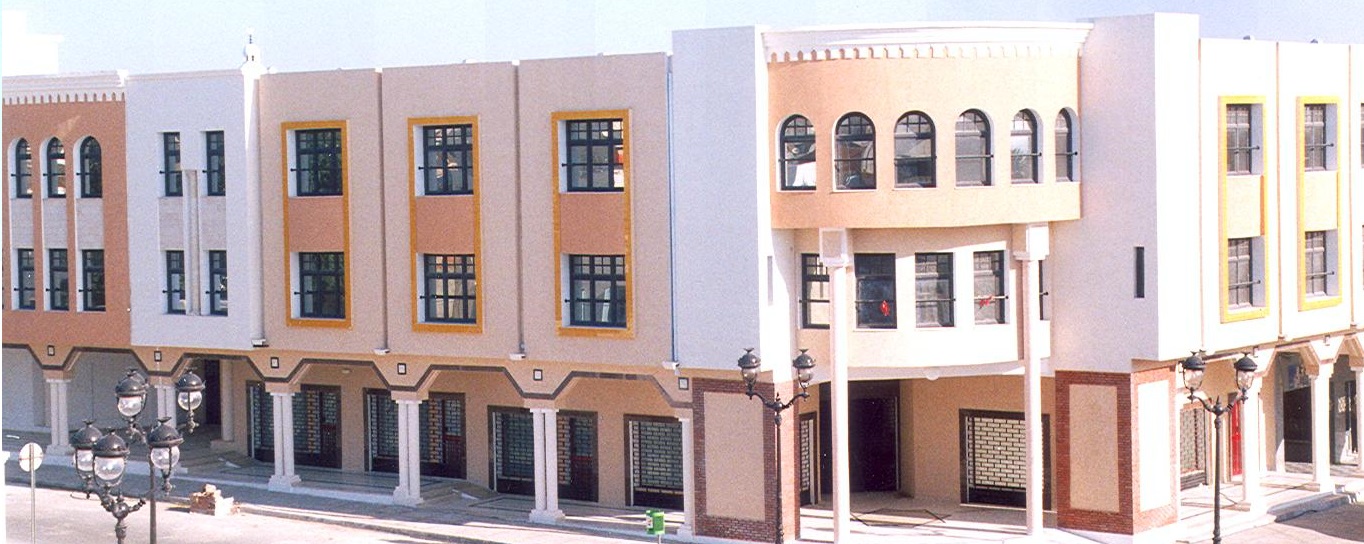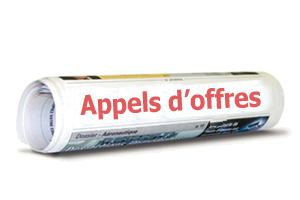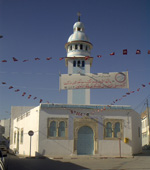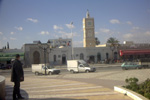Archaeological and historical sites :
- The museum :
The museum of Moknine collects the various remains and the various archaeological trinkets that are found in the region of the city. A new museum is built on scientific bases, and aesthetic excellent to become an important cultural space.
- The Medina :
There is the goldsmith's market.
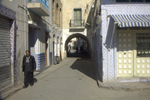
Life in the city :
- The amphitheater :
- Construction date : 1999
- The cost : 405.000 dinars
- The capacity : 3400 spectators
- Cultural space for young people :
"The house of the people" is a place of instruction and leisure at the same time, the young people meet there to participate in the instructive, sporting and leisure activities. There are various workshops and clubs.
- Transportation :
In Moknine we find :
- A station for buses.
- A new station for renting.
- A well-equipped, illuminated main train station (metro) with a cost of 111,000 dinars.
Religious monuments :
- The mosques :
There are a total of 29 (07 mosques in sermon and 22 mosques).
|
|
|
In Moknine, craftsmanship still maintains its importance, and participates in competition at international level. One can quote the pottery that was born before the Christian era, in the Punic and Roman times according to some researchers, since some ovens found in the region date from those eras.
Moknine is known for its various activities since the time of the Hafsides in the year 650 of the Hegira: the time of the construction of the first mosque, the Moorish bath and the establishment of the market in the city.
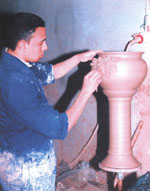
The various craft activities
- The pottery
- Goldsmithing
- Embroidery
- Tannery and Leather Goods
- The work of L'alfa, mats and scourtins
- The laundry
- Woodwork
- Forge
- Building and masonry
These handicrafts have contributed to the development of the city of Moknine. The latter has become prosperous and rivals the biggest cities of the Sahel.
The Mokenine woman excelled in the art of embroidery long before the gold wire called in Arabic "tell" was introduced into Tunisia at the end of the nineteenth century. The "tell" is a flat wire of silver plated gold imported from France. In Europe, it is used to embroider the clothes of kings, princes and great generals. In Spain, it is used to decorate the clothes of "toreros" and those of the musicians of the king.

Moknine's woman used the gold thread as soon as she was imported into Tunisia, instead of the cotton and silk threads, to embroider the bride's clothes.
The art of embroidery in Moknine is ancestral, it has artistic characteristics that subjugate the girls and the women. Besides, each one wants to offer a complete embroidered trousseau.

This artisan craft was established in Moknine and participated in the creation of the market (Wednesday) where are displayed embroidered clothes next to the goldsmith market known a little more than a century ago.
It contains all the pieces of the bride's habit, especially since today this art has developed greatly and innovation in this field has given rise to different models.
There are now hundreds of artisans (a dozen a few years ago), thanks to the encouragement of ONA (the national craft office), which still provides artisans with cheap gold wire To encourage the development of this business.

There is also a Presidential Award to encourage innovation in this area. A large living room is made available to craftsmen each year to exhibit their products and their creations in Tunis and at fairs at regional level.
In the second half of the 20th century and especially in the 1970s (70), Moknine experienced a prodigious rise in gold and silver workmanship (silver and gold) with the creation of the National Crafts Office. The latter participated in the training of the workforce, he prepared for this trade the young people of Moknine in the vocational schools.

Anyone who passed the aptitude test to obtain the right of the punch receives a monthly quantity of gold bullion that he buys from the office to transform it.
Moknine shone in the production and trade of gold jewelry, previously the activity of the Jews of that city. (At the beginning of the century, there were about ten Jews who monopolized goldsmithing until independence and the creation of the National Crafts Office.)

In Moknine, different models of jewelery are produced: Tigar, Menaguech, Khrass, Rehana, Kechkech of the necklace, tlila, khlakel, Dabbah and other khnatech to adorn the necklaces. All her models were highly prized by the women of Moknine and other cities like Mahdia, Sousse, Tunis.

In order to be marketed, these parts must comply with the standards and punched by the master goldsmith.

The punched part is guaranteed. This encourages the possession of gold which is considered a kind of saving.
|
1- Bounda |
|
2- Takrita Mouachah |
|
3- Hram Hrir |
|
4- Chemla |
|
5- Hzam Hrir |
|
6- Hzam Sbia |
|
7- Khiout |
|
8- Souria |
|
9- Seroual |
|
10- Koufia |
|
11- Kmeja |
|
12- Farmla Mahdaoui |
|
13- Farmla jeloua |
|
14- Farmla Tahzim |
|
15- Kantouche |
|
16- Kmamat |
|
17- Tricot Fadhila |
|
18- Mharma Marchoucha |
|
19- Mlaffa |
|
20- Mandil |
|
1- Farq |
|
2- Tlila |
|
3- Kotba |
|
4- Kleda |
|
5- Skhab |
|
6- Kannouta |
|
7- Le Tigar |
|
8- Monguache |
|
9- Rihana de visage |
|
10- Rihana de poitrine |
|
11- Khlal |
|
12- Kholkhal |
|
13- Kholkal |
|
14- Dhabbah |
|
15- Mikias |
|
16- Ounis |
All the civilizations of the world have known the carriage, and each has left its imprints which distinguish it from the others. This craft developed with history until the Chinese ceramics is distinguished from the Egyptian pottery, Tunisian .... The models, in pottery, differ from each other in shapes and colors.
The pottery of Moknine is marked by the seal of distinction and excellence given the location of the city and the nature of the raw material used. We must not forget the social and civilizational roles that pottery played in society.
The Tunisians have always used pottery made in Moknine throughout all periods: Punic, Phoenician, Carthaginian and Roman…
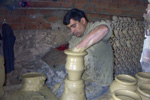
The Europeans have used Moknine pottery for two thousand years: archaeological excavations and remains exposed at the museum of lamta (in the Sahel) confirmed this fact. The port of Lamta exported from the sea, Sahel products such as oil and cereals in large pottery jars, made in Moknine.
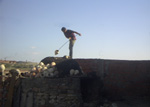
This ancestral craft was able to persist through the abundance of clay the main raw material. In the 1990s, there were about forty pottery workshops; At the end of the twentieth century there are about seventy workshops and three factories able to compete in the local and international market. And these three plants export to European, Asian and American countries.
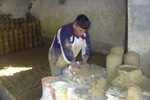
The uses of the poetry :
The Halleb was made to drink; The Kolla (small jar), the Khabia (jarre) to collect water; The Tajine (stove) the Kaskas (couscoussier) for the kitchen. Khabia and jarra also served for the conservation of cereals, vegetables of oil etc....
A hundred models and formats of pottery books are used for different services to meet the needs of man in different places and times.



